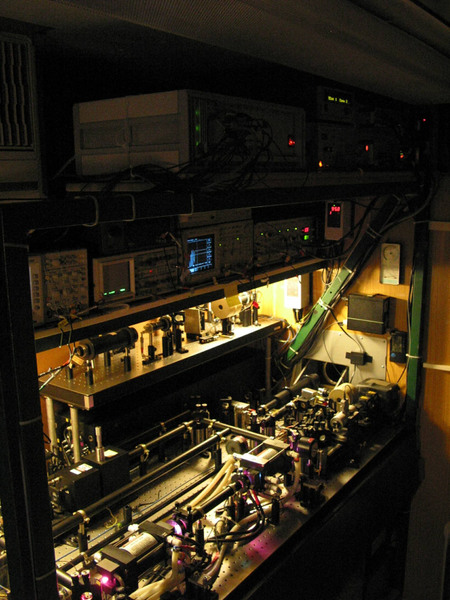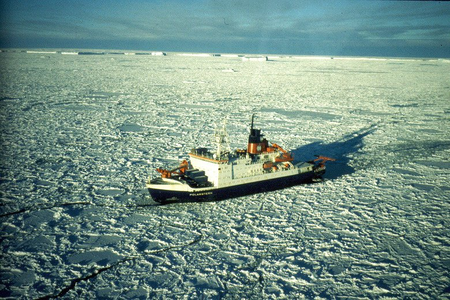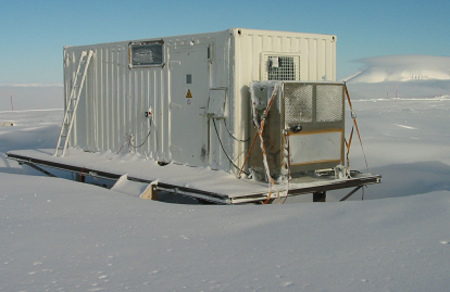Temperature soundings between Arctic and Antarctic
Observations at different locations are important for a better understanding of the spatial and temporal behaviour of the thermal structure of the atmosphere temperature. Such measurements can be performed with good temporal and spatial resolution between 80 and 105 km altitude with the worldwide unique mobile Doppler lidar for the mesosphere/lower thermosphere, the containerised potassium resonance lidar (figure 1). First successful measurements have been demonstrated in 1995 at Juliusruh (54°38 ’N, 13°24 ’E) [Höffner and von Zahn, 1995].
Afterwards in 1996 measurements on board the research vessel “Polarstern” have shown for the first time the latitudinal dependency of the mesopause from 71°S to 45°N (figure 2). With these measurements the bimodal behaviour of the mesopause, the so-called “two level mesopause”, was discovered [von Zahn et al., 1996]. Simultaneously the potassium layer was measured and a model of the potassium layer was developed (Eska et al., 1999]. Between June 1996 and February 1999 the mobile lidar was operated routinely at the IAP Kühlungsborn (54◦07 ′N, 11◦46 ′E). With continues measurements about several years at a single location the existence of the two level mesopause was approved [She und von Zahn, 1998] and new findings about the seasonal behaviour of the potassium layer have been obtained [Eska et al., 1998]. These measurements also show the existence of free metal atoms above 110 km altitude [Höffner and Friedman, 2004]. For the first time the metal ratio of ablating meteoroids entering the atmosphere have been obtained by combining the measurements of the K-lidar with the nearby metal lidar [von Zahn et al, 1999]. Since 2001 temperature measurements are performed with a second new stationary K-lidar in conjunction with a RMR lidar. This combination allows simultaneous measurements of temperatures from the troposphere to the lower thermosphere.
The mobile K-lidar was operated between March 1999 and December 2000 at the canaries island Tenerife (28◦18 ′N, 17◦31 ′W) at 2390 m for the examination of the two level mesopause at low latitudes. At Tenerife first measurements with a newly developed daylight filter have been performed [Fricke-Begemann et al.,2002]. At the end of 2000 a continuous measurements about seven days have been achieved [Fricke-Begemann und Höffner, 2005]. Between May 2001 and August 2003 the lidar was located at 450 m altitude on the island of Spitsbergen (78◦14 ′N, 15◦23 ′E) (figure 3). Beside the study of NLC and their seasonal behaviour [Höffner et al., 2003] the main aim was the determination of the thermal structure of the mesopause. Starting in 2004 the K-lidar was reconstructed for improved measurements at daylight [Lautenbach and Höffner, 2004], being the worldwide first iron Dopplerlidar. The new iron lidar was used for a one year campaign at ALOMAR before it was shipped to Antarctica. There at the Australian research station Davis (69°S) the lidar was deployed for more than two years between end of 2010 and beginning of 2013. In Summer 2014 the Fe lidar was again installed at the ALOMAR observatory (69°N).
Selected publivations
- R. Wörl, B. Strelnikov, T. P. Viehl, J. Höffner, P.-D. Pautet, M. J. Taylor, Y. Zhao und F.-J. Lübken, Thermal structure of the mesopause region during the WADIS-2 rocket campaign, Atmos. Chem. Phys., 19, 77-88, doi:10.5194/acp-19-77-2019, 2019.
- B. Kaifler, F.-J. Lübken, J. Höffner, R. J. Morris und T. P. Viehl, Lidar observations of gravity wave activity in the middle atmosphere over Davis (69°S, 78°E), Antarctica, J. Geophys. Res., 4506-4521, doi:10.1002/2014JD022879, 2015.
- F.-J. Lübken, J. Höffner, T. P. Viehl, E. Becker, R. Latteck, B. Kaifler, D. Murphy und R. J. Morris, Winter/summer transition in the antarctic polar mesopause region, J. Geophys. Res., 120, 12,394-12409, doi:10.1002/2015JD023928, 2015.
- T. P. Viehl, J. Höffner, F.-J. Lübken, J. M. C. Plane, B. Kaifler und R. J. Morris, Summer time Fe depletion in the antarctic mesopause region, J. Atmos. Solar-Terr. Phys., 97-102, doi:10.1016/j.jastp.2015.04.013, 2015.
- F.-J. Lübken, J. Höffner, T. P. Viehl, B. Kaifler und R. J. Morris, Winter/summer mesopause temperature transition at Davis (69°S) in 2011/2012, Geophys. Res. Lett., 41, 5233-5238, doi: 10.1002/2014GL060777, 2014















